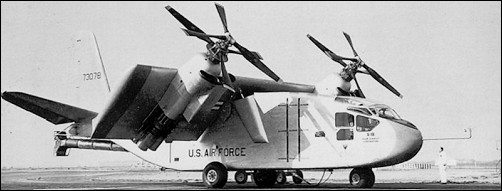Hiller Aircraft was one of the pioneers in VTOL flight and investigated the possibilities of the phenomena following World War II. Its investigations pointed to the advantages to be derived from the Tilt-Wing concept. It generated enough interest from the Navy, with its expertise receiving a contract in 1957 for a four-ton payload, tilt-wing transport.
The company's potential also attracted the interest of the Air Force in 1954. Three years later, the Air Force pushed for the construction of a prototype and a flight test program, and awarded the company a $4 million contract to accomplish the awesome task. Even though the plane was built from scratch as a research-gaining testbed, the X-18 definitely carried the look of an era transport. It would also be the largest VTOL aircraft built to date at the time.
The contract called for a twin-engine, Tilt-Wing convertiplane. In addition to its vertical take-off and landing capabilities, the X-18 was also required to have a significant forward speed capability of about 640km/h.
Another consideration of the flexibility of the plane was that where landing strips were available, the X-18 could be used in a conventional take-off mode, resulting in an increased payload capability. The model was to also be constructed using as much conventional fabrication techniques as possible. The task was aided greatly during its early phases by a series of wind tunnel tests at NACA Langley, Virginia. The first, and only, prototype was completed in 1958, and quickly became involved in an extensive ground test program.
The first actual flight test took place on November 24, 1959. There would be twenty flights in the program, with the program ending in July 1961. It was that final flight of the program that actually spelled disaster.
When a problem occurred with one propeller's pitch control system, it served as the main reason for the termination of the program. The fact that the engines were not cross-shafted together contributed to worries with the program.
But after the flight testing was over, there was still another important mission to be performed by the X-18. During this phase, the plane would serve to generate a data base for the four-engine XC-142 Tilt-Wing transport that would follow.
During its final days, the X-18 would be damaged when a ground test stand upon which it was mounted failed. Shortly thereafter, the X-18 - like a number of the other X planes - would be disassembled and cut up for scrap.
Looking at the mechanicals of the X-18, it quickly comes to light that this was an extremely complicated machine and certainly was pushing the state-of-the-art for the time period.
The propulsion system, although it wasn't immediately evident when viewing the plane, carried three engines. Besides the obvious pair of Allison T40-A-14 turboprops, each mounting a pair of Curtiss-Wright turbo-electric three-bladed propellers and putting out a total of just over 11000 horsepower, there was also a 1530-kg-thrust Westinghouse J-34 turbojet located in the aft fuselage that provided the greatly-needed pitch control. It was located in the aft fuselage. The T40, by the way, was the same engine that was used in the Convair XFY-1 "Pogo" Tail Sitter VTOL fighter.
The thrust from this auxiliary engine was diverted through a pipe that protruded out the rear of the aircraft and terminated with an up-and-down diverter valve. By applying the thrust in either an up-or-down direction, the devise was able to maintain the craft's pitch control.
The T-40 props were huge � 4.8m in diameter - with the props geared to be counter-rotating. The engines provided significant lift thrust, providing the X-18 with excellent performance through transition from vertical to horizontal flight. Following transition to its forward velocity mode, the X-18 acquired the look of a conventional transport, and it was hard to even identify its VTOL capability.
The cockpit featured a standard cockpit layout, but stability augmentation was built into the roll and pitch axes. Hydraulic boost was used on the ailerons, and a jet diverter and a servo tab boost on the rudder. The only additional control on the cockpit panel was a lever to tilt the wing, which was mechanically locked in the full-down position, but hydraulically locked when in the intermediate positions.
The X-18 airframe certainly wasn't a from-scratch project, but instead was derived from a montage of existing aircraft parts and pieces. The main fuselage, which was 19.8m in length, was a modified Chase XC-122C model with other parts coming from a R3Y transport. Its construction did not require any unconventional techniques or components, which resulted in a great time savings in the overall project.
The fuselage was actually cut in half during the construction process and stretched to a length which was required to meet the center of gravity and landing gear requirements. For simplicity reasons, the tricycle landing gear was fixed in the deployed position. During horizontal flight, the X-18 carried the look of a standard transport, although the wings looked a bit stubby.
The high-set 14.6m-span wing, though, was a new design, with the engines nearly centered between the fuselage centerline and the wingtips. Interestingly, there were no flaps, but ailerons, with the actual tilting of the wing accomplished by a pair of hydraulic pistons. The high-set wing was designed to rotate through a complete 90 degrees, enabling a pure helicopter vertical transition.
The X-18 weighed 12150kg empty and 14850kg loaded. Compared to the other VTOL craft of the time period, the X-18 was a large aircraft and required each main Allison T-40 engine to lift 7430kg, as compared to the 5400 to 6300kg for each of the Tail-Sitter VTOL projects.
From the pilots' point-of-view, the X-18 was rated as a fairly easy aircraft to learn. That came from the fact that the cockpit controls were practically identical to any turboprop transport of the period, the only addition being the wing-tilt lever.
S.Markman & B.Holder "Straight Up: A History of Vertical Flight", 2000





